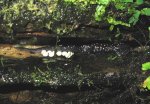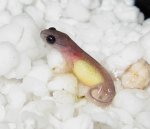taherman
Caudata.org Donor
Definitely a first in Toledo, we have a female glut on exhibit tending a clutch of eggs. She is enthusiastically defending them from cagemates. This has probably been in captivity either 4 or 8 years (individuals are not uniquely identified in the exhibit).
Anyone else here have experience with Plethodon eggs? Obviously it is best to leave them with the female, though the enclosure may have to be torn out before they hatch (major renovations are coming to the amphibian facilities). Any advice, or tips if they have to be moved, would be much appreciated.
-Tim Herman
Anyone else here have experience with Plethodon eggs? Obviously it is best to leave them with the female, though the enclosure may have to be torn out before they hatch (major renovations are coming to the amphibian facilities). Any advice, or tips if they have to be moved, would be much appreciated.
-Tim Herman


